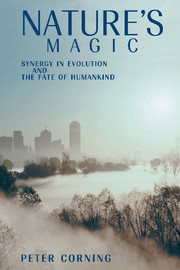Book contents
- Frontmatter
- Contents
- 1 Prologue: The New Evolutionary Paradigm
- 2 The “Enchanted Loom”
- 3 The Magic Castle
- 4 “Black Magic”
- 5 The Synergism Hypothesis
- 6 “The Sorcerer's Apprentice”
- 7 Conjuring Human Evolution: The Synergistic Ape
- 8 Conjuring History: Does Cultural Evolution Have an “Arrow”?
- 9 The Science of History
- 10 Conjuring the Future: What Can We Predict?
- Afterword
- Notes
- References
- Index
2 - The “Enchanted Loom”
Published online by Cambridge University Press: 22 August 2009
- Frontmatter
- Contents
- 1 Prologue: The New Evolutionary Paradigm
- 2 The “Enchanted Loom”
- 3 The Magic Castle
- 4 “Black Magic”
- 5 The Synergism Hypothesis
- 6 “The Sorcerer's Apprentice”
- 7 Conjuring Human Evolution: The Synergistic Ape
- 8 Conjuring History: Does Cultural Evolution Have an “Arrow”?
- 9 The Science of History
- 10 Conjuring the Future: What Can We Predict?
- Afterword
- Notes
- References
- Index
Summary
The brain is waking and with it the mind is returning … Swiftly the head-mass becomes an enchanted loom, where millions of flashing shuttles weave a dissolving pattern … a shifting harmony of sub-patterns.
Charles S. SherringtonSherrington's famous metaphor for the human mind could be applied to the rest of nature as well. The natural world could be likened to an enchanted loom that weaves a golden tapestry of synergy. For synergy is all around us, and within us; we are completely dependent on it. Yet we often take it for granted or fail to appreciate its gravitas, its weightiness. It's profoundly paradoxical. And potentially dangerous. (We'll come back to this point in the final chapter.)
A Golden Tapestry of Synergies
Let's start our survey with something as ordinary as the humble clay brick, one of humankind's oldest and least honored technologies. Without a plan for how to use them and a supply of mortar (itself a synergistic combination of cement, lime, sand, and water), a pile of bricks will be … well, a pile of bricks. But when the bricks are arranged in precisely ordered patterns and then bonded together they “collaborate” to form a great variety of structures: factories, fireplaces, canals, churches, prisons, watchtowers, garden walls, roads, sidewalks, even kilns for making more bricks.
When the Toronto Maple Leafs recently moved out of their famed Maple Leaf Gardens after 67 years of making hockey history (every game had been sold out since 1949), a sentimental remembrance in a Toronto newspaper noted that the Gardens in its heyday was one of the largest brick buildings in the world.
- Type
- Chapter
- Information
- Nature's MagicSynergy in Evolution and the Fate of Humankind, pp. 8 - 34Publisher: Cambridge University PressPrint publication year: 2003



